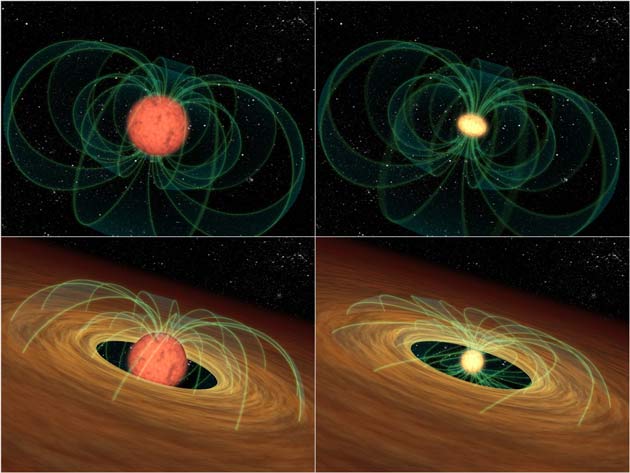Why Fast-Spinning Young Stars Don't Fly Apart

Young stars are loaded with energy, and they can spin around in half a day or less, compared to the 28 days it takes our more mature Sun to make a revolution.
But young stars would spin even faster if something didn't hold them back.
Now scientists say they think they've figured out at least one thing that slows them down: disks of planet-forming gas and dust, just as had been long suspected.
Nearly out of control
Stars collapse from clouds of gas and dust. As they contract, they spin faster and faster, like a twirling ice skater pulling her arms in. Leftover gas and dust flattens out into a disk, and the material in it can clump together to form planets.
Developing stars spin so fast that, left unchecked, they would never fully contract and become stars. A disk tugs at a star's magnetic field, something like a spoon moving through molasses, the researchers said.
The support for this scenario, announced today, is based on new observations from NASA's Spitzer Space Telescope, which found that slow-spinning stars are five times as likely to have a disk as fast spinners.
Get the Space.com Newsletter
Breaking space news, the latest updates on rocket launches, skywatching events and more!
"We can now say that disks play some kind of role in slowing down stars in at least one region, but there could be a host of other factors operating in tandem," said study leader Luisa Rebull of NASA's Spitzer Science Center. "And stars might behave differently in different environments."
Other factors that contribute to a star's winding down over longer periods of time include stellar winds and possibly full-grown planets.
More study needed
So do stars with planets spin more slowly than stars without planets? Not necessarily, Rebull explained. Slowly spinning stars might simply take more time than other stars to clear their disks and develop planets. Such late-blooming stars would, in effect, give their disks more time to put on the brakes and slow them down.
More insight will have to wait until more planets around other stars of varying ages and speeds are discovered.
The research was detailed in the July 20 issue of the Astrophysical Journal. The Spitzer Science Center compares the spin of stars to a skater in this video about the new findings.
- Top Ten Star Mysteries
- The Strangest Things in Space
- Magnetic Fields Nudge Matter Into Black Holes
- Wildest Weather in the Galaxy
Join our Space Forums to keep talking space on the latest missions, night sky and more! And if you have a news tip, correction or comment, let us know at: community@space.com.

Space.com is the premier source of space exploration, innovation and astronomy news, chronicling (and celebrating) humanity's ongoing expansion across the final frontier. Originally founded in 1999, Space.com is, and always has been, the passion of writers and editors who are space fans and also trained journalists. Our current news team consists of Editor-in-Chief Tariq Malik; Editor Hanneke Weitering, Senior Space Writer Mike Wall; Senior Writer Meghan Bartels; Senior Writer Chelsea Gohd, Senior Writer Tereza Pultarova and Staff Writer Alexander Cox, focusing on e-commerce. Senior Producer Steve Spaleta oversees our space videos, with Diana Whitcroft as our Social Media Editor.









